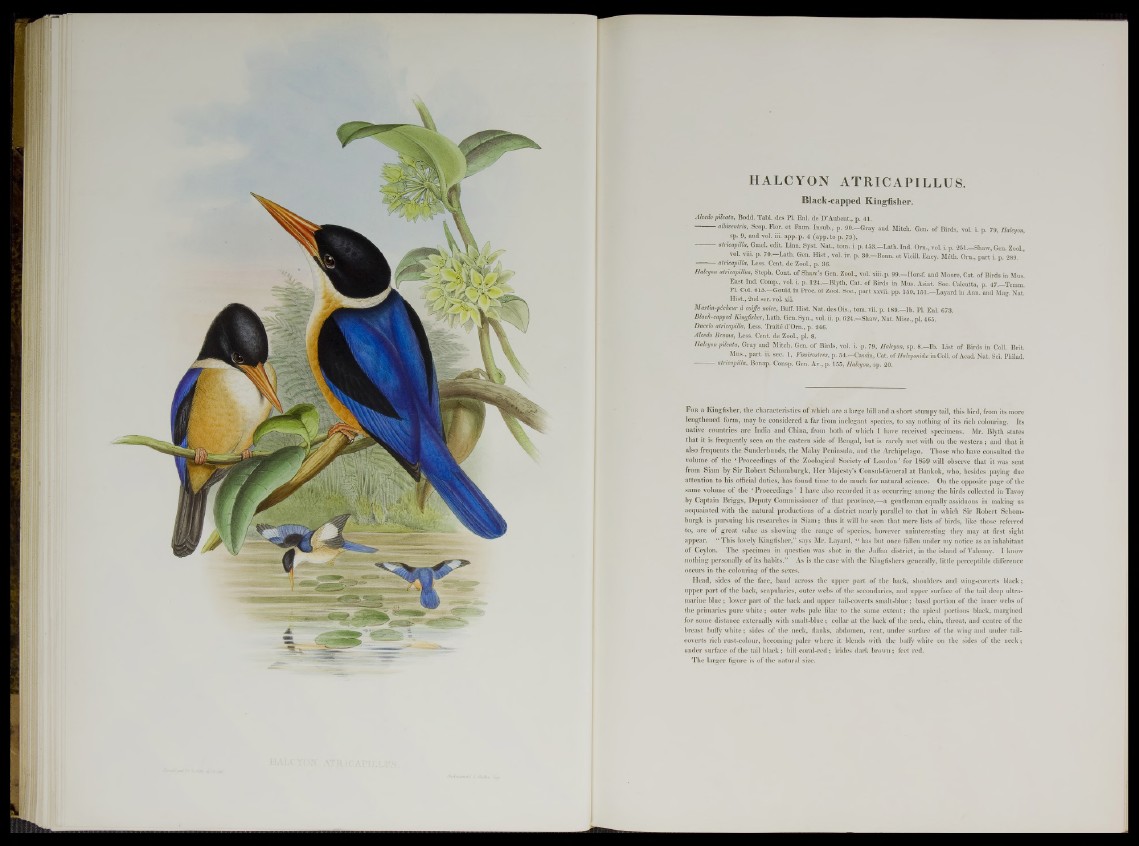
HALCYON ATRICAPILLUS.
Black-capped Kingfisher.
Alcedo pilcata, Bodd. Tabl. des PL Enl. de'D’Aubent., p. 41.
«“ *«»**. 8«>P- Flor. et Faun. Insub., p. 90.—Gray and Mitch. Gen. of Birds, vol. i. p. 79, Halcyon,
sp. 9, and vol. iii. app. p. 4 (app. to p. 79).
K ? f |f - Gmel. edit. Linn. Syst. Nat., tom. i. p. 453.—Lath. Ind. Orn., vol. i. p. 251—Shaw, Gen. Zool.,
vol. viii. p. 70.—Lath. Gen. Hist , vol. iv. p. 30.—Bonn, et Vieffl. Ency. Méth. Om., p art i. p. 289.
atricapilla, Less. Cent, de Zool., p. 36.
Halcyon atricapillus, Steph. Cont. of Shaw’s Gen. Zool.,, vol. viii.p. 99.—Horsf. and Moore, Cat. of Birds in Mus.
East Ind. Comp., vol. i. p. 124.—Blyth, Cat. of Birds in Mus. Asiat. Soc. Calcutta, p. 47—Temm.
PI. Col. 613—Gould in Proc. of Zool. Soc., p art xxvii. pp. 150,151— Layard in Ann. and Mag. N a t
Hist., 2nd ser. voL xii.
Martin-pêcheur à coiffe mire, ¡Buff. Hist. Nat. des Ois., tom.vii. p. 189.—Ib. PI. Enl. 673.
Black-capped Kingfisher, Lath. Gen. Syn., vol. ii. p. 624.—Shaw, Nat. Misc., pi. 465.
Dacelo atricapilla, Less. Traité d’Om., p. 246.
Alcedo Brama, Less. Cent, de Zool., pi. 8.
Halcyon, pileata, Gray and Mitch. Gen. of Birds, vol. i. p. 79, Halcyon, sp. 8.—Ib. List of Birds in Coll. Brit.
Mus., part. ii. sec. 1, Fissirostres, p. 54.—Cassin, Cat. of Halcyonida in Coll. o f Acad. Nat. Sci. Philad.
atricapilla, Bonap. Consp. Gen. Av., p. 155, Halcyon, sp. 20.
F or a Kingfisher, the characteristics of which are a large bill and a short stumpy tail, this bird, from its more
lengthened form, may be considered a far from inelegant species, to say nothing of its rich colouring. Its
native countries are India and China, from both of which 1 have received specimens. Mr. Blyth states
that it is frequently seen on the eastern side of Bengal, but is rarely met with on the western; and that it
also frequents the Sunderbunds, the Malay Peninsula, and the Archipelago. Those who have consulted the
volume of the * Proceedings of the Zoological Society of London ’ for 1859 will observe that it was sent
from Siam by Sir Robert Schomburgk, Her Majesty’s Consul-General at Bankok, who, besides paying due
attention to his official duties, has found time to do much for natural science. On the opposite page of the
same volume of the ‘ Proceedings ’ I have also recorded it as occurring among the birds collected in Tavoy
by Captain Briggs,- Deputy Commissioner of that province,— a gentleman equally assiduous in making us
acquainted with the natural productions of a district nearly parallel to that in which Sir Robert Schomburgk
is pursuing his researches in Siam; thus it will be seen that mere lists of birds, like those referred
to, are of great value as showing the range of species, however uninteresting they may at first sight
appear. “ This lovely Kingfisher,” says Mr. Layard, “ has but once fallen under my notice as an inhabitant
of Ceylon. The specimen in question was shot in the Jaffna district, in the island of Valenny. I know
nothing personally of its habits.” As is the case with the Kingfishers generally, little perceptible difference
occurs in the colouring of the sexes.
Head, sides of the face, band across the upper part of the back, shoulders and wing-coverts black;
upper part of the back, scapularies, outer webs of the secondaries, and upper surface of the tail deep ultramarine
blue; lower part of the back and upper tail-coverts smalt-blue; basal portion of the inner webs of
the primaries pure white; outer webs pale lilac to the same extent; the apical portions black, margined
for some distance externally with smalt-blue; collar at the back of the neck, chin, throat, and centre of the
breast buffy white; sides of the neck, flanks, abdomen, vent, under surface of the wing and under tail-
coverts rich rust-colour, becoming paler where it blends with the buffy white on the sides of the neck;
under surface of the tail black; bill coral-red; irides dark brown ; feet red.
The larger figure is of the natural size.